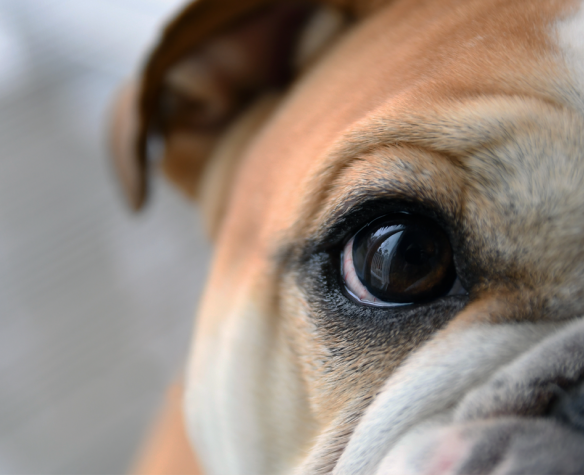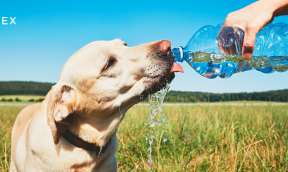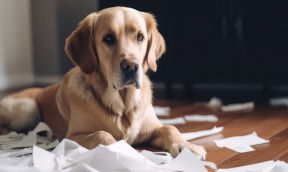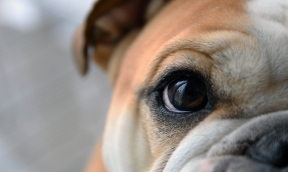
Cleaning your dog’s eyes: essential daily care
Contents: What are the 6 steps involved in cleaning a dog’s eyes? | What equipment is essential for your pet’s eye hygiene? | Why should you clean your dog’s eyes? | How often should you clean your dog’s eyes? | How can you tell if a dog has an eye problem? | FAQ on cleaning a dog’s eyes
Cleaning your dog’s eyes is an essential part of your dog's health and hygiene routine. How do you clean your pet’s eyes? Which products should you use? How can you tell if a dog has an eye problem? Here Francodex answers your questions.
What are the 6 steps involved in cleaning a dog’s eyes?
Cleaning your dog’s eyes is easy as long as you are gentle but firm and your pet trusts you.
Here are the 6 steps to follow for perfect eye hygiene:
- Wash your hands before caring for your dog. If it has an infection, we recommend that you wear gloves.
- Sit your dog comfortably on your lap or next to you. Stroke it and only start cleaning its eyes once it’s calm.
- Gently squeeze the bottle and run the eye lotion around the eye contour area and over the eyelid.
- Wipe off any excess liquid with a compress, without rubbing the eye. For sensitive animals, pour some of the lotion directly onto a compress, then wipe off any impurities without rubbing the skin. The eye contour area should be cleansed working from the inner corner outwards to avoid drawing impurities into the tear duct.
- Repeat the operation with the other eye, using a new clean compress.
- Reward your pet with a pat or a treat.
If your pet has an eye infection, no doubt your vet will have prescribed a treatment based on eye drops or antibiotic creams. You can apply the treatment to the eye after cleaning around the eye. If the treatment is to be applied several times a day, Francodex recommends that you lightly clean your dog’s eyes before each application.
🐶 Tip for getting a puppy accustomed to eye care: teaching a dog to let you handle it is an essential stage in its training. Teeth cleaning, paw pad care,and ear and eye hygiene are all key to keeping your pet healthy and comfortable. You can introduce your pet to this treatment by first using a multi-purpose pet cleansing wipe to wipe the area around the eye. Always do this somewhere quiet, once you are both settled comfortably.
What equipment is essential for your pet’s eye hygiene?
To clean your pet’s eyes, Francodex recommends that you get all the necessary equipment ready in advance, so that you can proceed with the treatment in the best possible conditions.
Preferably use reusable compresses or make-up remover squares, as, unlike disposable tissues or cotton wool, there is no risk of them leaving threads behind or falling to pieces during use.
You can use saline solution to clean a dog’s eyes. However, we recommend that you use an eye cleansing lotion containing the cleansing and moisturising agents that are vital to your pet's health.
Francodex has an “Eye Care” cleansing lotion for dogs and cats containing organic cornflower hydrolate. To keep puppies’ and kittens’ eyes clean, we recommend an eye cleansing lotion designed for young animals.
If you want to give your pet nature’s best, you'll also like Biodène's eye cleanser, made with 99% natural ingredients. It contains organic rose and cornflower hydrolates, known for their decongestant, soothing and toning properties.
Why clean your dog’s eyes?
Dogs produce tears through their lacrimal glands, located under the eyelids. Like in humans and cats, their purpose is to lubricate the surface of the eye and create a protective barrier.
However, day and night, secretions can accumulate in the corner of the eye, particularly if they are produced in excessive quantities or if they are poorly evacuated.
How do dogs shed their tears? Tears evacuate through the tear ducts. These two openings, called the lacrimal puncta, located at the inside corner of the eye, collect the tears, which then pass through the nasolacrimal duct towards the nasal cavities. If the impurity-laden tears cannot pass through these ducts, they accumulate.
In such cases, the dog’s eyes need to be cleaned to maintain good eye hygiene.
Which breeds are more prone to excessive tearing? Some breeds of dog are more prone to excessive tearing because of their ocular and facial anatomy: French and English Bulldogs, Shih Tzu, Pekingese, Bichon Frise, Cavalier King Charles, Poodle, Yorkshire Terrier, etc. This characteristic can lead to the appearance of brown spots on the coat around the wings of the nose, as well as skin problems around the eyes.
How often should you clean your dog’s eyes?
In breeds prone to excessive tearing and brown marks, Francodex recommends daily eye cleaning, or at least twice a week.
For other breeds of dog, this care should be carried out whenever you notice excessive discharge from the eyes. If the discharge persists, your pet seems to be in discomfort or its eyes are red, consult a vet.
Excessive eye discharge in dogs can be caused by:
- environmental factors (dust, pollen, pollution);
- medical conditions (allergies, infections, blocked tear ducts);
- mechanical irritants (foreign bodies, injuries).
Times when there may be excessive eye discharge include exposure to irritating environments or stressful situations. If in doubt, consult your vet and tell them as much as possible about the environmental conditions that preceded the irritation or discharge.
How can you tell if a dog has an eye problem?
Cleaning your pet’s eyes offers an opportunity to take a closer look at them. The earlier a disorder is identified and treated, the greater the chances of a rapid cure.
Symptoms of an eye problem
To tell if a dog has an eye problem, look out for signs such as:
- excessive discharge;
- redness;
- swelling;
- sensitivity to light;
- excessive blinking or closing of the eyes.
Changes in the colour of the iris or cornea, visible scratches or unusual behaviour, such as rubbing the eyes with the paws, may also suggest there is a problem.
Causes of ophthalmic problems in dogs
Eye problems can be caused by:
- bacterial or viral infections,
- allergies,
- foreign bodies,
- trauma,
- structural abnormalities, such as blocked tear ducts.
Underlying diseases, such as glaucoma, cataracts or corneal ulcers, may also explain the symptoms observed.
Francodex has developed a protective eye gel to lubricate dry, irritated eyes. It contains carbomer, a substance that forms a protective aqueous film on the cornea.
This gel is suitable for dry eyes in older or sick dogs, or dogs whose morphology predisposes them to dry eyes (bulging eyes). Ask your vet for advice before using any new product.
⚠️ No cortisone treatment without prior diagnosis: never use a cortisone-based product without first having your dog’s eye examined by a vet. Minor trauma to the cornea, such as a scratch or a foreign body stuck inside the eyelid, can damage the cornea and create an ulcer, i.e. a “hole” in the surface of the eye, which is very painful. Applying an unsuitable product can aggravate the problem rather than improve it, and lead to serious eye damage, including, on occasion, blindness in the affected eye.
Eye treatment
The treatment of an eye problem depends on its cause.
It can include:
- eye drops or antibiotic creams for infections,
- antihistamines for allergies,
- surgery for cataracts or glaucoma.
A veterinary consultation is essential for an accurate diagnosis and appropriate treatment.
Taking special care of your pet’s eyes will keep it healthier and happier for longer. Although sight is not a dog’s most highly developed sense, it nevertheless enables the animal to detect movement, even at a distance, something that is key to its sense of direction, and to escape in the event of danger.
FAQs on cleaning a dog’s eyes
How do you remove the brown from around a dog’s eyes?
To remove the brown from around a dog’s eyes, gently clean the area with sterile saline solution or Francodex veterinary eye cleaner.
Use a clean compress for each eye, wiping from the inner corner outwards.
Also, make sure you trim the hair around your dog’s eyes regularly in order to avoid:
- corneal irritation and injury,
- maceration of the skin under damp hair.
Consult a vet if the problem persists, as this may indicate an underlying problem requiring treatment.
How do you hydrate your dog’s eyes?
To hydrate your dog’s eyes, use hydrating eye drops or a protective eye gel specially formulated for animals, as recommended by your vet.
Apply the treatment to each eye, gently parting the eyelids. Repeat as required, according to the instructions on the product.
Do not use human products, with the exception of saline solution.
How do you protect a dog’s eyes?
There are a number of things you can do to protect your dog’s eyes:
- clean them regularly with Francodex eye solution to remove impurities and excessive discharge;
- avoid dusty and polluted environments;
- trim the hair around the eyes to prevent irritation;
- use protective eyewear for dogs during outdoor activities such as cycling or hiking;
- treat any signs of infection or irritation immediately.
Article written with the assistance of
Dr Stéphanie Padiolleau, veterinary surgeon




